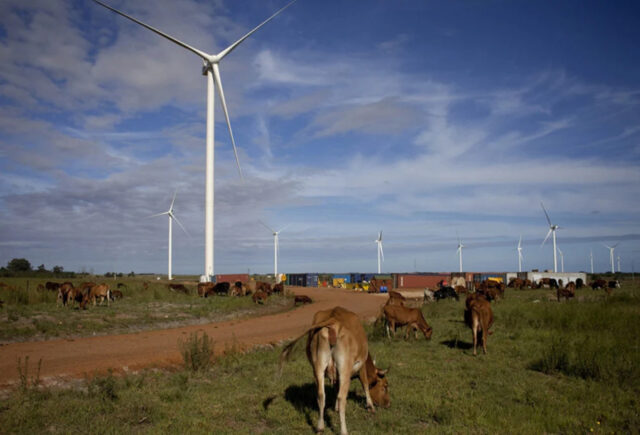A report by the UN Environmental Programme highlights the many challenges faced by the real estate sector on its path to net zero, and finds discrepancies between the commitments made and the roadmaps to fulfil them

In brief
- The study documents the experience of participating financial institutions in using the Carbon Real Estate Monitor (CREEM) tool to measure and manage real estate transition risks
- It is the first to look at the issues in Asian markets in detail, and the conclusions are startling
- Retrofitting is vital – most buildings that will exist in 2050 have already been built
- Problems with data, especially concerning fluorinated gases used in refrigeration, mean the sector’s existing roadmaps are inadequate
It is estimated that the built environment contributes some 39% of greenhouse gas emissions, meaning the the decarbonisation of the real estate sector is “a must for our climate and our planet”.
This is according to areport recently published by the UN Environmental Programme (UNEP) Finance Initiative. The ‘Managing Transition Risks in Real Estate’ paper assesses the state of real estate assets and the challenges the sector faces to align to net zero.
It documents the experience of participating financial institutions – real estate investors and banks- in using the Carbon Real Estate Monitor (CREEM) tool to measure and manage real estate transition risks.
In 2020, the properties in this study had a combined energy consumption of approximately 3.3 billion kWh, resulting in GHG emissions equivalent to no less than 1.24 million tonnes . “This demonstrates the massive challenge faced to reach full decarbonization, or net-zero emissions, by 2050,” the report says.
Forty four percent of assets were held over 10–20 years, and 31% for more than 20 years. “These long holding periods show why it is important that investors and asset owners conduct transition risk analyses on their assets.”
The study is is also the first project carried out to assess Paris alignment of real estate portfolios in Asia, and the findings are startling.
‘Retrofitting vital’
“By 2050, only around 1% of all assets will be Paris-compliant. As a majority of properties in the sample portfolio are top-certified ‘trophy’ assets, properties achieving a ‘gold’ sustainability label today will still have to undergo massive energetic retrofits and other measures to decarbonize to net zero by 2050.”
“There is a growing risk of stranded assets and write-downs” particularly in South Korea, China, Singapore, and Hong Kong.
The report argues that buying green energy is positive, but it should be the last option to be considered to decarbonize a property.
“For real estate, a special focus must be placed on operational GHG emissions, since most buildings that will exist in 2050 have already been built. Aggressive retrofitting and refurbishment within the existing property stock is [therefore] a strategic priority.”
Thanks to calculations of embodied carbon, the construction of a new commercial property generates approximately 1,000 kg of embodied emissions.
This means that a new office building or shopping centre with even the best energy certificate “starts its lifecycle with a huge carbon footprint. This fact shows that simply constructing highly efficient or even ‘zero-energy’ buildings cannot deliver decarbonization.”
If rather than demolishing and rebuilding an existing building, say 60–80% of its structure can continue to be used, this avoids the emissions associated with 25–35 years of use.
Yet, “there is insufficient focus on intensified energetic retrofit measures and the allocation of the respective capex budgets. Leading to overly negative return on investment calculations for energetic retrofit.”
Need for better roadmaps
The authors note that in many discussions with investors, they “continue to see a large discrepancy between commitments and clear roadmaps to fulfil these commitments”.
Often, decisions are made solely on the basis of internal company-level return requirements. Management often underestimates fundamental climate changes and the tightening regulatory framework already underway.
Perhaps because there is a lack of qualified in-house specialists or external consultants meaning there is insufficient knowledge about potential solutions.
Much of the world is moving to decarbonise the production of electricity. However, this effect does not mean market participants can avoid taking action. As of 2020, less than 2% of total energy consumed was supplied from renewables.
There may be very limited potential for high-rise office towers, to produce a significant amount of renewable energy on-site. However, “other properties, such as shopping centres and logistics facilities, have rooftops and large land areas which may enable their owners to generate renewable energy on-site.”
Transparency and data quality must be further improved
The report found big data gaps. Almost a quarter of institutions were surprised to learn that they were exposed to substantial transition risk and will need to take action. Only 6% of respondents were happy with the positioning of their assets.
To overcome industry challenges, asset owners and managers need to prioritize improving data collection and management. 41% of respondents “only had some of the asset-level information needed to carry out transition risk analysis.” 29% said they did not have enough information available to carry out transition risk analysis
“Further improvements in data coverage and tracking energy consumption within tenant areas is needed. A ‘whole-building’ approach must be applied.” Using assumptions to fill data gap leads to more risks in the future. A quarter of respondents at least partially used their own assumptions for asset-level data, only 6% did not need to make any assumptions.
“Even a slight difference in the methodology for calculating floor area will change… the carbon assessment. To ensure a like-for-like comparison, users should report the gross internal area of the asset, aligned with the International Property Measurement Standards.”
One major data gap is the impact of the fluorinated gases used in refrigeration, with the authors calling for building owners to switch to more environmentally friendly alternatives.





